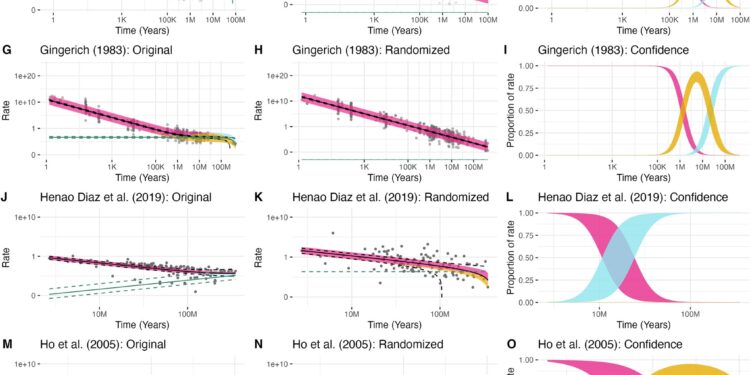Comparisons of log-linear trends in rates of evolution. Credit: PLOS Computational Biology (2024). DOI: 10.1371/journal.pcbi.1012458
For decades, researchers have observed that rates of evolution appear to accelerate over short periods of time, say five million years versus fifty million years. This general pattern suggests that groups of organisms that are “younger,” in evolutionary terms, exhibit higher rates of speciation, extinction, and body size evolution, among other differences from older groups. .
Evolutionary processes appear to operate on different time scales, perhaps requiring a new theory linking microevolution and macroevolution. The larger question that concerns scientists is: why?
There are plausible explanations. A new species can inhabit a new island chain, allowing for more variation as it spreads into new niches. An asteroid could hit Earth, increasing extinction rates. Perhaps species evolve toward an “optimal” trait value and then stabilize.
An article published in PLOS Computational Biology now proposes an entirely new explanation for understanding this evolutionary model: statistical “noise”. The article, “Noise Drives Perceived Increases in Evolutionary Rates on Short Time Scales,” was written by Brian C. O’Meara, professor in the Department of Ecology and Evolutionary Biology at the University of Tennessee, and Jeremy M. Beaulieu. , associate professor in the Department of Biological Sciences at the University of Arkansas.
The authors note that “employing a new statistical approach, we discovered that this time-independent noise, often overlooked as inconsequential, creates a misleading hyperbolic pattern, giving the impression that evolutionary rates are increasing over periods of time.” shorter when in fact they do. In other words, our results suggest that smaller, younger clades (groups with common ancestors) appear to evolve more quickly, not because of intrinsic properties, but because of statistical noise. »
The study blends mathematics, statistics and biology to show that this long-standing hyperbolic model is an anomaly because it fails to account for the fact that all species on Earth are defined as much by their unique traits as by the variation that exists in these traits. .
It is a common principle in science that the simplest explanation possible to fit the data is usually the correct one. Evolution occurring on completely different time scales is much less likely than the noise of numbers.
Ultimately, the study highlights the critical importance of accounting for biases and errors inherent in interpreting biodiversity patterns on shallow and deep time scales.
In an unpublished summary of their work, the authors note that “(o)ur results could be considered earth-shattering: a trend that could have launched a thousand papers with really interesting biological hypotheses can be explained as an artifact.
“However, this is actually progress: we have explained a common pattern we see in the world. Biology is rich in mysteries: answering one of them allows us to move on to the next. It There are still many questions about biological rates, but the current paradigm of calculating rates as a function of time should probably end.”
More information:
Brian C. O’Meara et al, Noise leads to perceived increases in evolutionary rates over short time scales, PLOS Computational Biology (2024). DOI: 10.1371/journal.pcbi.1012458
Provided by University of Arkansas
Quote: Study suggests statistical ‘noise’ affects perceived rates of evolution (October 3, 2024) retrieved October 3, 2024 from
This document is subject to copyright. Except for fair use for private study or research purposes, no part may be reproduced without written permission. The content is provided for informational purposes only.



